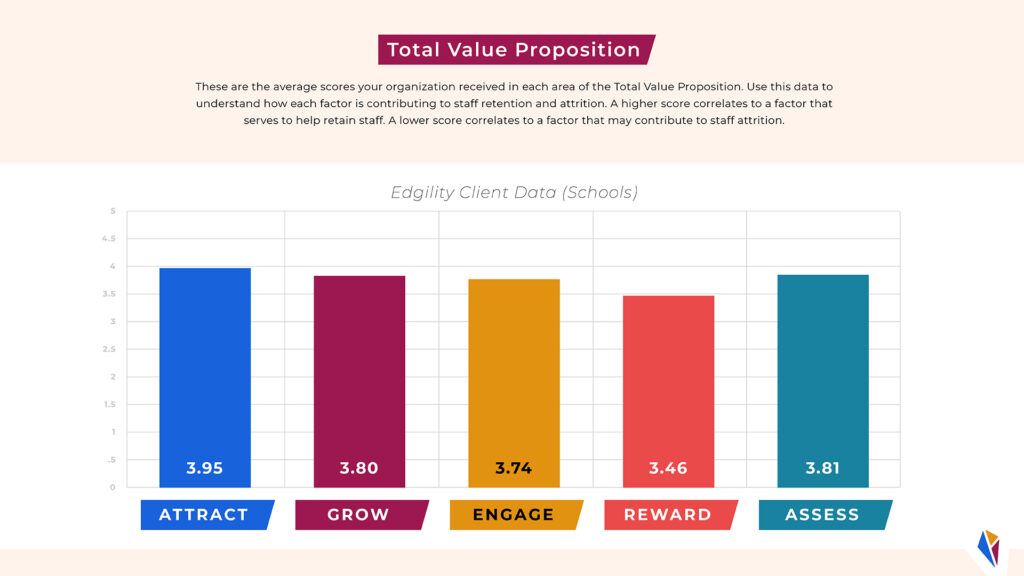
Maximizing Talent Retention: The Power of the Total Value Proposition
By Jennifer Svendsen
In today’s tumultuous educational landscape, fostering a sense of engagement and inclusion among school staff is paramount. To achieve this, leadership must listen to the diverse voices within their staff to understand both the “glows and grows” of their organization, and take action on the areas that need attention. With competing priorities, challenges with staff retention, and budget restrictions, school leaders are facing an uphill climb, but you aren’t alone. Our team at Edgility recognizes the importance of this process and developed what we call the Talent Equity Assessment (TEA). The TEA is an invaluable tool that provides a comprehensive framework for identifying and improving key areas of staff dissatisfaction. During this process, we survey staff and utilize what we call the Total Value Proposition (TVP) in conjunction with the TEA to create a holistic view of the state of talent management at the organization. Dive in with us as we define and explore the core areas behind each facet of the TEA survey and its significant connection to both attracting new talent and retaining existing staff members.
Understanding the Talent Equity Assessment (TEA):
If you’ve led talent engagement work before, these areas may sound familiar, but if you’re new to it we suggest taking a moment to read and digest the five buckets that make up our TEA. Our team has identified these 5 critical areas below as significant indicators of staff engagement: attract, grow, engage, reward, and assess. Each of the following components serves a distinct purpose in assessing the overall staff experience within an educational institution (or any organization).
- Attract: The “attract” bucket is designed to understand how schools draw in and recruit their staff. It delves into the clarity of job descriptions, the school’s reputation, and the appeal of its mission and vision. Attracting talent is the first step in building a strong team, and schools must ensure that potential staff members align with their values and mission.
- Grow: The “grow” bucket focuses on opportunities for career advancement and professional development. It’s important to acknowledge that more than likely, staff have diverse aspirations. Some educators may be content with their current roles, while others aspire to climb the professional ladder. By providing a clear growth path, coaching and development opportunities, schools can cater to the diverse career goals of their staff.
- Engage: The “engage” bucket revolves around how well schools keep their staff motivated, happy, and satisfied with their roles. Engaging staff goes beyond monetary compensation and includes alignment of work with organizational values, opportunities to contribute and be heard, and prioritizing mental and physical wellness. Studies have shown that high levels of engagement correlate with lower staff turnover, which underscores the importance of creating a nurturing work environment.
- Reward: The “reward” bucket is about fair compensation and recognition for the work done. Staff members should feel that they are adequately compensated and recognized for their hours of work. Clear and fair compensation philosophies and structures are essential to attract and retain the best talent and demonstrate the value placed on staff contributions.
- Assess: The “assess” bucket evaluates the way staff performance is measured including whether organizations provide clear and reasonable goals, a fair performance evaluation system, and recognition when an organization falls short of creating an environment where staff can perform effectively. In my years of working with schools, it has become clear that evaluating staff based solely on student achievement may not be the most effective approach. And based on teacher sentiment, I would argue it is something that schools should remove from their evaluation process altogether. While student outcomes are crucial, assessments should also consider the broader contributions staff make to the school community.
The Holistic Approach to a Total Value Proposition (TVP):
The five buckets of the TEA together create a clear Total Value Proposition (TVP) (sometimes called Employee Value Proposition). A TVP is a comprehensive package that reflects an organization’s commitment to providing a meaningful and satisfying work experience. Importantly, a successful TVP should address the diverse needs of all staff members.
- Want to see how the TEA survey can help you identify opportunities for improvement? Check out our free mini-version.
For leadership, listening to staff feedback, such as the insights gained from the Talent Equity Assessment, is the first step toward creating a TVP that can adapt to the various facets of the staff experience. We know that teachers love working with students, the mission of their schools, and the impact that they have every day, so how do you show that the school appreciates them just as much? Teachers and school staff bring their passion, knowledge, and whole selves to their work every day, and their impact goes far beyond student achievement scores. However, doing so can cause burnout if the school isn’t set up to support their team. Our experts urge school leaders to understand that engaging this holistic approach to the TVP is crucial for long-term talent retention and organizational success. Don’t believe us? The research speaks for itself. Here are some numbers from our work with clients.

The TEA is powerful because it enables us to see how different identities experience your organization. This data allows leaders to address gaps by identifying and increasing inclusion and retention.
Studies in organizational behavior and human resources have shown that an effective Total Value Proposition (TVP), which encompasses five key areas, can significantly influence staff engagement, satisfaction, and retention. The Society for Human Resource Management (SHRM) has identified compensation, work-life balance, career development, and workplace culture as some of the factors that influence job satisfaction.

The second part of our TEA (shown above) is the NPS score, which measures staff loyalty to your organization. These scores represent how staff loyalty is impacted by a TVP that doesn’t encompass a holistic and inclusive approach.
Research by Gallup has found that engaged employees are 59% less likely to look for a job with a different organization in the next 12 months, highlighting the correlation between engagement and retention. Employees who feel supported in their career goals, adequately compensated, and appreciated for their contributions are less likely to seek opportunities elsewhere. With more data suggesting that employee satisfaction increases with a well-rounded talent management strategy, including the areas noted in the TVP, it’s vital that schools begin to prioritize this work.
Moving Forward
Schools that aim to enhance engagement and inclusion among their staff need to roll up their sleeves and embrace the combined power of listening and taking action. For leaders, utilizing tools like the Talent Equity Assessment can be the ace in your hand. There are a lot of ways to assess the five buckets we shared earlier (attract, grow, engage, reward, and assess) but in all of our years of supporting leaders and school staff, we know that our holistic approach can create lasting, positive change. So leaders, are you ready to get started?
Meet the expert:
Jennifer Svendsen
Principal
- Builds Equitable Organizations
- Talent Management Support
- Closes Wage Gaps






